5 Proven community growth strategies–that won’t burn you out
Creators may live for eyeballs.
But creators survive and thrive when they build and grow communities–real, engaged groups of people huddled around solving the same problems.
So how do you grow your community?
- Do you just post more?
- Create more?
- Market more?
- Comment more?
- More more more?
⛔ The harsh truth is doing more for the sake of more is a path straight to burnout.
Instead, we put together a guide of tools, tactics, and strategies you can use to both grow your audience, and engage your current members–using startup marketing tactics that won’t burn you out.
In this article, we’ll help you understand:
- How to use your community as an audience growth multiplier
- 5 systematic community growth strategies
- Why you should treat your community like a product, and
- Best practices for growing your community
Plus, we’ll dive into a quick case study featuring Exit Five—the #1 community for B2B marketers that has grown 100% year over year—to find out the exact steps they’re taking to grow and engage their community.
What’s the difference between community growth vs. community-led growth
Community growth and community-led growth are two distinct concepts and shouldn’t be confused.
Community growth simply means increasing the size of your community, which could include audience, membership, or business growth. It involves attracting new members, encouraging participation, and nurturing a vibrant and active community–which then helps retain and attract others.
Community-led growth is a marketing strategy used by companies to build communities of enthusiastic customers. It’s a popular marketing strategy used by companies like Notion and Figma–and when done well, it adds massive value to the product experience. This strategy doesn’t usually center the community, but uses community to add value in addition to a product or service.
Community-led growth is how the smartest creators and businesses:
- Get new features, product, and offering ideas from their top contributors
- Create a supportive member-member community (while freeing up time and space for them to scale)
- Help members get the most value out of your content
- Get those warm leads from good word-of-mouth and referrals
- Create a network effect of happy customers that act as free advocates for your business
- Get great social proof to continue promoting their business
It doesn’t matter if you have a paid membership, a cohort-based community, or a product or course-based community–you can apply the same strategies and tactics to your advantage.
5 Systematic strategies to grow your community
Whether you’re just learning more about creating a community for your audience, or thinking about migrating your members, there are strategies you can use to make growth automated and automatic.
And while you may have heard of funnels, the truth is:
Funnels are out, and flywheels are in. 🔁
Especially when it comes to community–which lends itself to continuous, circular improvements over time, rather than just “landing” a member and then forgetting they exist once you have their money.
Community-led growth is an incredible framework to apply to creator and brand communities–because it flips the “buying cycle” upside down. Instead of a purchase being the end of your journey, a community-led strategy means that when people buy your product, course, or service and get into a community–it’s just the beginning of their engagement with you.

1. Attract your audience (like a marketer)
When you think about growth, you need to think like a marketer.
While you may be fantastic at your core business of creating content, or courses, or coaching–if you don’t know how to get the right people to see it, your business won't grow.
That’s why in order to grow your community, at baseline, you need to build awareness. The best way to do that is to have:
- A strong point-of-view: have the courage to be controversial or disliked. Don’t create simply for the purpose of being disliked, but know that standing out in a saturated market means knowing how you’re different. For example, Codie Sanchez is all about being a contrarian. People who resonate with that are drawn to her.
- A platform: Whether that means you’ve started a newsletter for all your followers, a podcast, a job board, or just make use of the socials (LinkedIn, Twitter, TikTok, Bluesky etc)–you need to do like Ariel and “be where the people are”. For Exit Five, LinkedIn is their biggest source of members (60%!), so that’s where they double down and spend all of their time prospecting and posting.
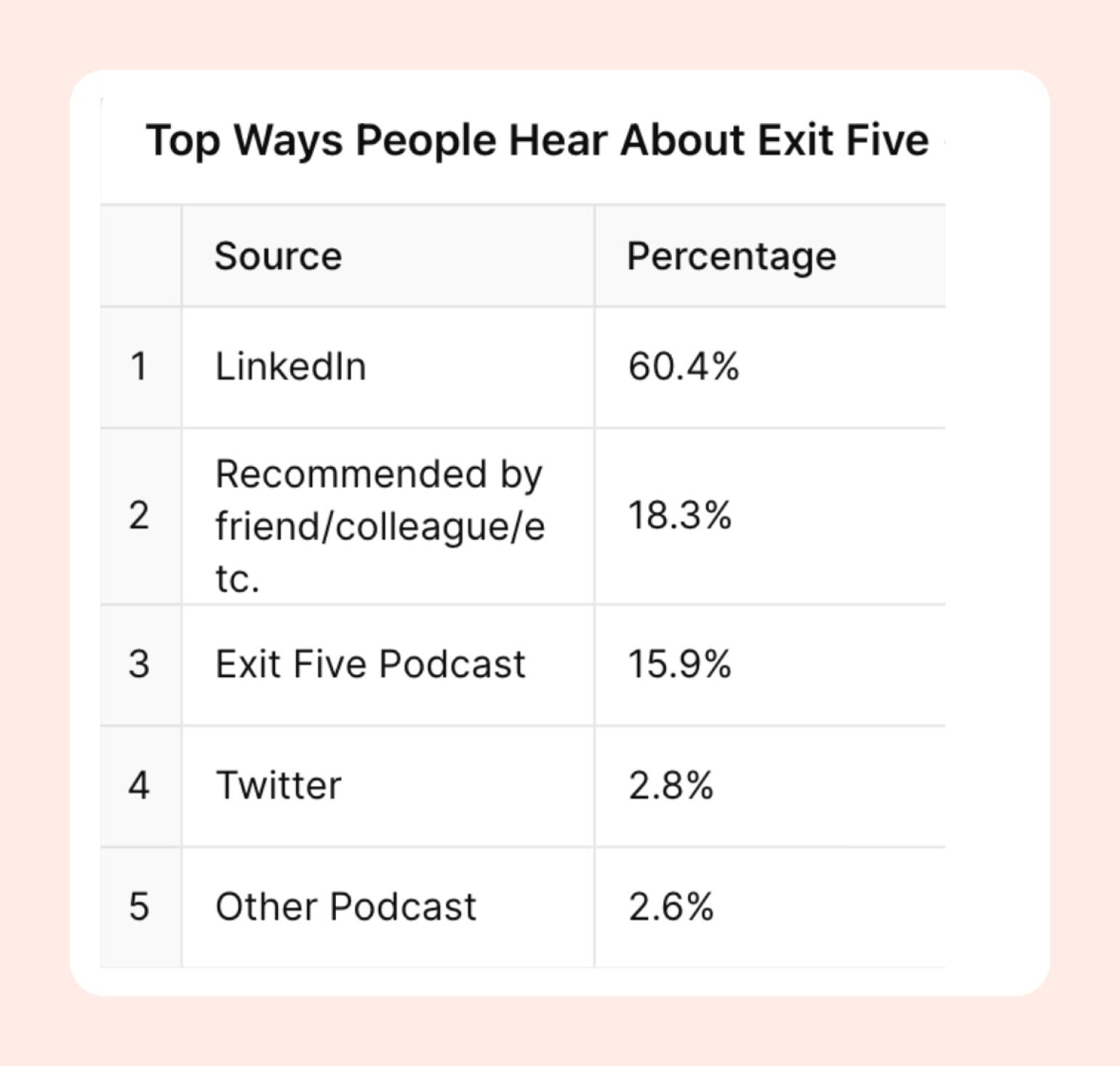
- A consistent posting cadence: Business growth is boring once you’ve found something that works. But in order to attract the audience your business deserves (and get more ROI for every member), you need to be consistent in sharing your POV with your target audience. Exit Five’s top employees post every day. Jay Clouse used to email his list every day for a year until he dropped to a weekly cadence. The key is…
- A regular content analysis: Did daily posts work for you–or did engagement and shares drop? What topics did people respond to most from your newsletter? Did one blog post get more backlinks than any others? Why? Where are conversations cropping up naturally and excitedly amongst your target audience?
2. Add a call-to-action to help you nurture prospects
Your ultimate goal as a business owner is helping as many people as possible with your content–but part of that goal is getting them in your funnel (or flywheel) so that they opt-in to your stuff, which means you need calls to action (CTAs).
There’s many ways to think about CTAs, but the one we like is breadcrumbs.
Matthew Carnevale, Head of Community at Exit Five, explains breadcrumb CTAs: “They have to be something that your audience or passersby stumble upon while viewing your content. The key… is that they can't be too obvious.”
Here’s an example of a CTA from the founder of Exit Five, Dave Gerhardt, on LinkedIn: the “Subscribe to newsletter” link under his headline.
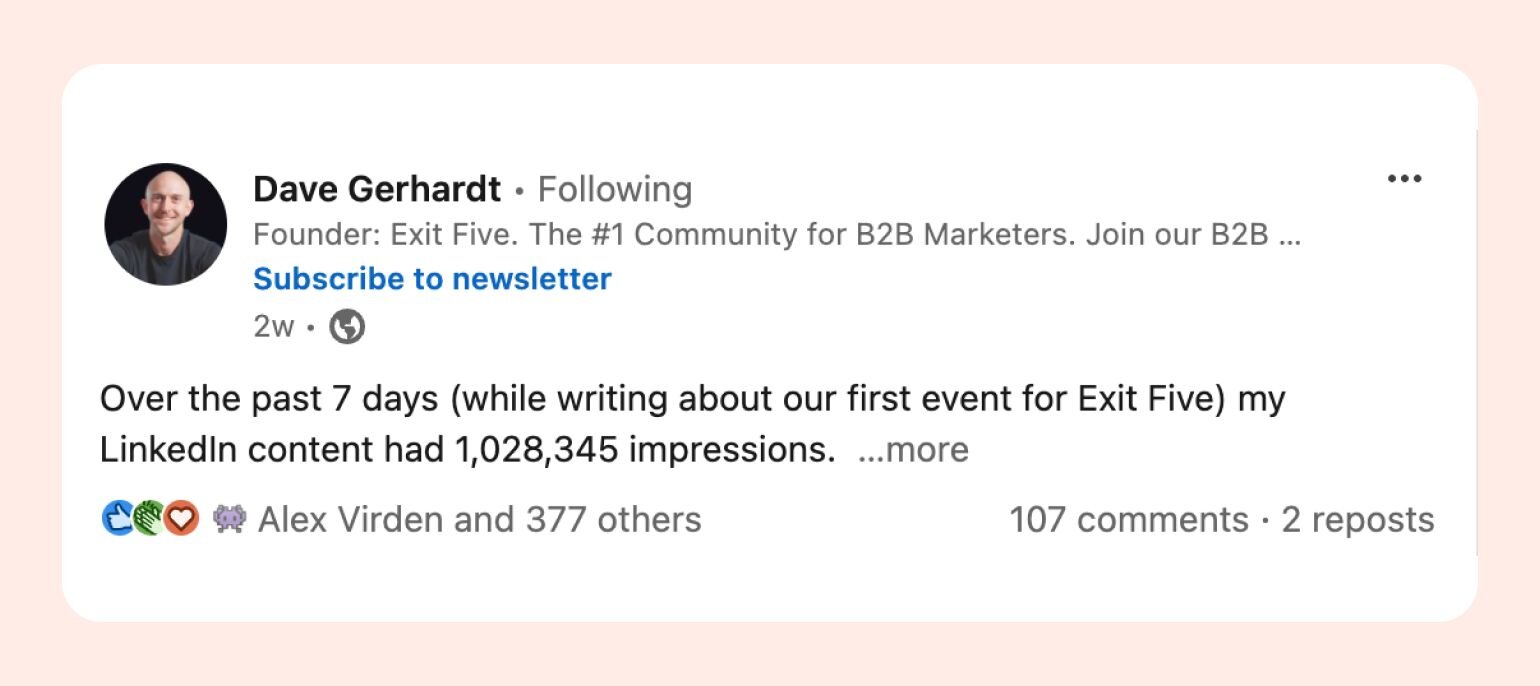
Smart (and consistent) CTAs turn readers on organic social into leads, and funnels them into an “owned platform” that you can then nurture into a sale. That means a place where you can gather their information, and use it to further market to them through emails, ads, content, or community.
Some examples of breadcrumbing CTA's:
- Newsletters
- Free communities (on platforms like Circle)
- Lead magnets like quizzes or assessments
- Free challenges
3. Embed your offers organically
Finally, once people are on your owned channel, whether that’s a newsletter or not–pitch them your offer.
You don’t have to get on the phone and car sales-man pressure them into it… but you do have to add both calls to action and pitches for your offer into your content consistently to:
- Bring awareness to your offerings
- Provide social proof about their value
- Remind them about it
- Until they’re ready to buy
Because the path to purchase isn’t linear.
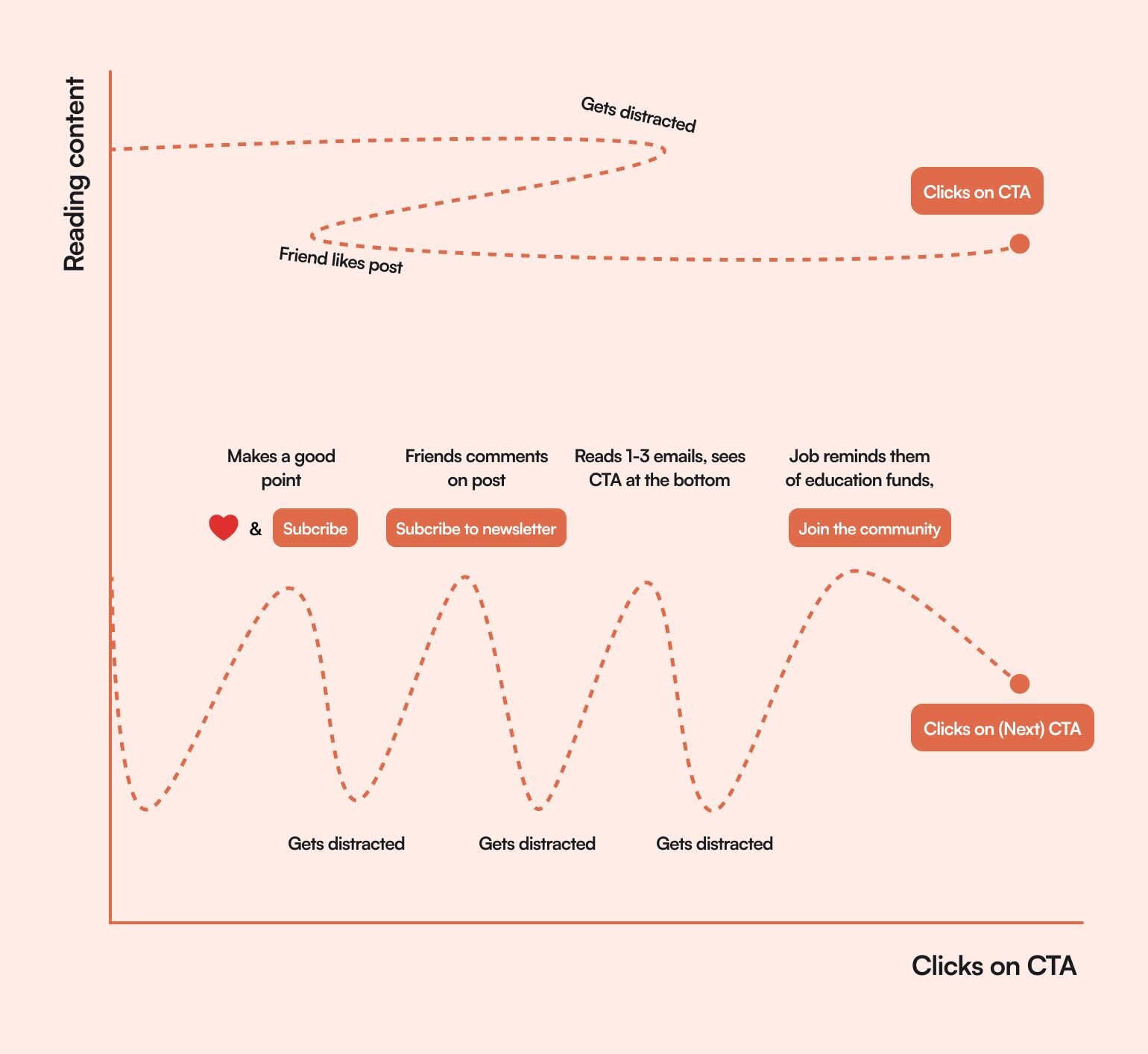
Whether you have a full offer suite set up or are just starting and nailing down one product, course, or service, there are ways to move people through the process by leveraging launches, evergreen sales, and seasonal sales or discounts. For example:
- A parenting community could promote a sale on mothers, fathers, and grandparents day
- A creator selling accounting spreadsheets can promote their evergreen training during tax season or within their link in bio
- A business coach could launch a new group coaching program in Q4 to help businesses create a plan for the following year
Exit Five keeps it simple, and embeds offers to join their community at the end of each newsletter they send out, which is a very common way to move prospects to take the next step.
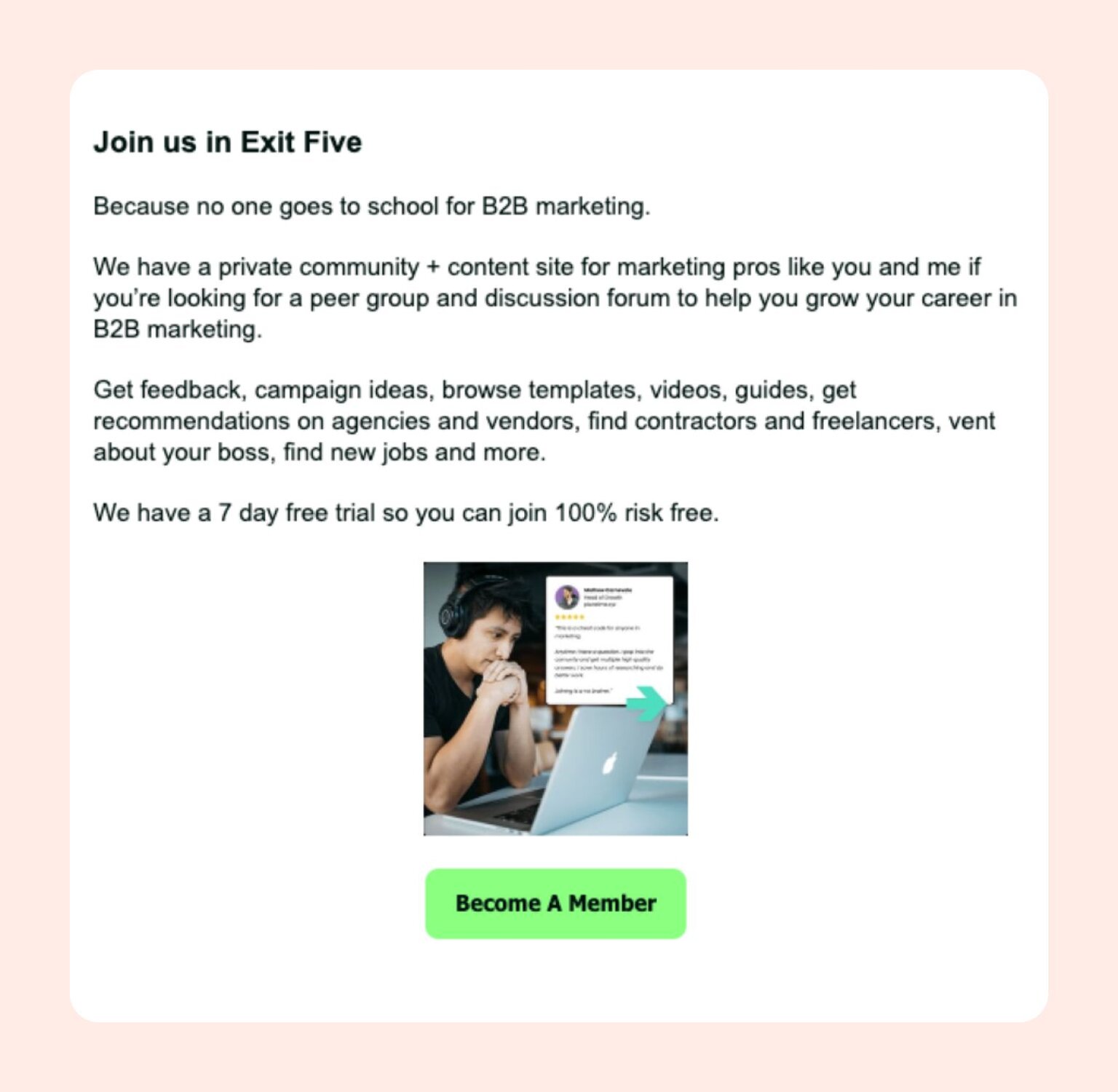
3.1 De-risk your pitch
Handing over your cold, hard-earned cash can feel scary to many. Risk reversals is a copywriting and sales technique that minimizes the perceived risk–and you can use it to make your offer seem like an “easy yes”.
Here are some examples of risk reversals:
- A free trial
- A money-back guarantee
- Extra bonuses
- A discount for new customers
- A free audit or assessment
- Performance guarantees (we’ll help you [blank] or your money back)
- Free shipping or easy returns if you sell products
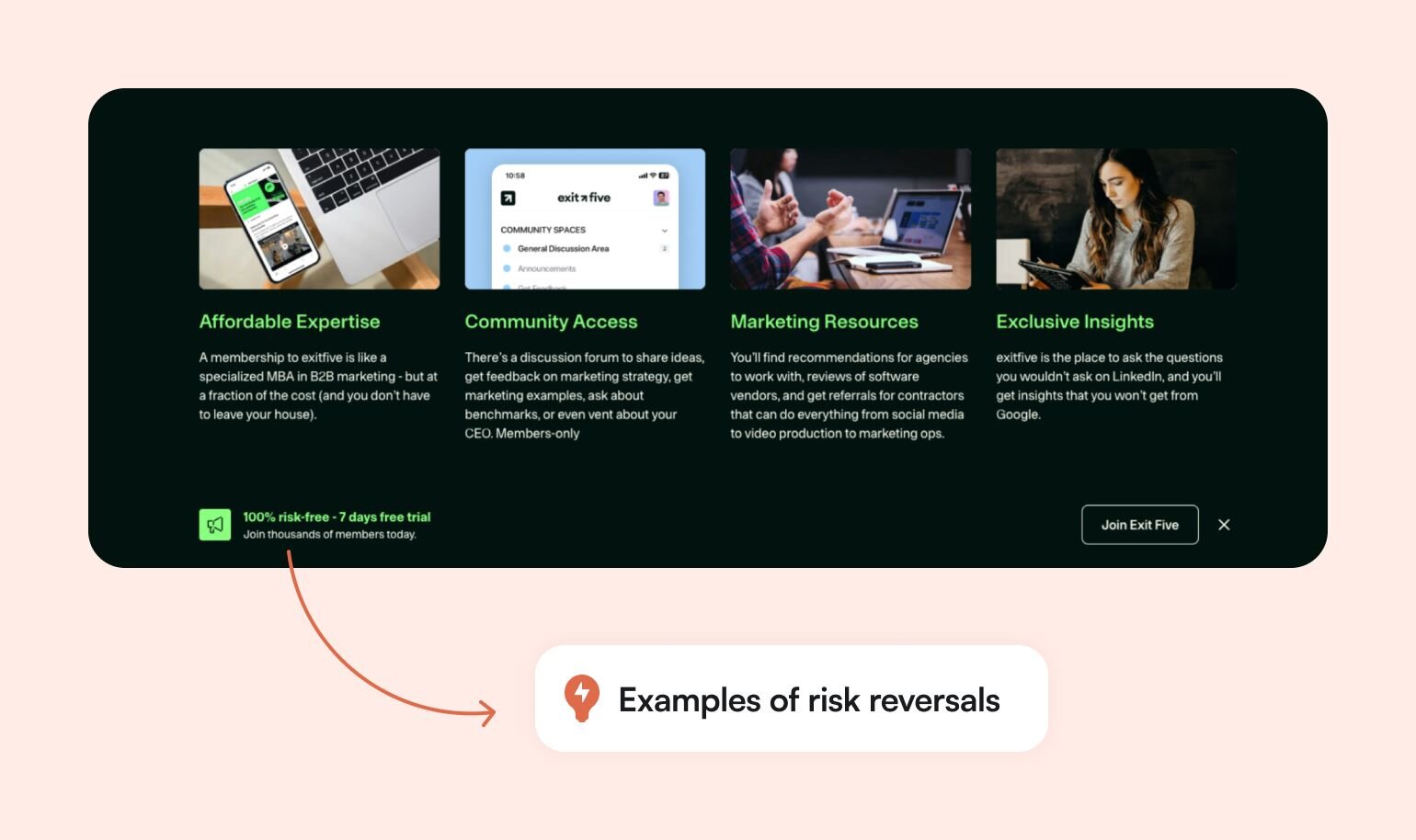
4. Treat your community like a product–always be improving
Lots of companies wouldn’t exist without their products–so they tend to treat their products with the utmost care.
They:
- Plan quarterly and yearly roadmaps (to outline what they’re want to test, introduce, add, or change)
- Invest in their maintenance
- Assess their value and impact
- Conduct customer interviews and feedback rounds
- Continuously improve on them
- Market them strategically
Because it’s hard to sell a product that nobody wants, you need to constantly be aware of the changing market and continue delivering value.
In order to apply this to your community, you need to build this product-thinking feedback loop into your community experience.
Using 1:1 member interviews, trends in Circle (or other CRMs), and other community signals like feature or product requests, you should:
- Create a hypothesis about what your community needs
- Build an iteration
- Test its value and impact
- Gather feedback
- Iterate on your offering
5. Promote your happy members to close the loop
Community-led growth relies on the network effect, and the psychological principle that people are more likely to buy something that their friends have bought (and liked).
You can use this principle to your advantage by:
- Sharing customer wins within the community
- Using customer stories in your marketing for the community (something Exit Five does on their homepage as well as elsewhere in their marketing)
- Talking about challenges customers have overcome with your community or product
- Creating a referral program that rewards your most loyal members for bringing in new members
The more engaged and happy your members are, the more likely they are to talk about your business, which makes it easier and easier to grow your community.
TLDR: Delighted customers are the best community growth strategy.
Best practices for community growth
- Show up consistently on your top platforms with a unique POV to grow your audience
- Create a simple funnel (or flywheel) that moves people to buy-in
- Lead with value (and don’t discount your knowledge)
- Pick the right tools and platforms (don’t overcomplicate your tech stack)
- Measure your metrics to understand your progress
- Membership metrics like number of members, growth rate (MoM or YoY), member type
- Engagement metrics like total activities (comments, posts, etc), active members (MAU), top trending topics
- Business metrics like customer acquisition cost (CAC), lifetime value (LTV), and retention and churn rates
- Encourage engagement through onboarding, live events, match-making, courses, etc
- Assess your assumptions and iterate!
Case study: How to grow a community like Exit Five
Exit Five is a $1.5M community that didn’t even start out as a community. It started with Dave Gerhardt sharing his thoughts on LinkedIn as a CMO, and gathering a massive audience that he eventually decided to figure out how to monetize.
Over the past year, Exit Five has added multiple employees, thrown an in-person conference, and grown their membership by over 100%.
Not only that, but they’ve managed to keep an enviously high MAU (Monthly Active Users) at 40% with a 4,300+ person community.
“It’s so hard to re-engage people if their first week or month isn’t good. So you want to get engagement right.” - Matthew Carnevale, Head of Community at ExitFive
Learn more about how Exit Five 10x'd their growth overnight by launching their very own branded community app.
What have they learned along the way?
- When you have high engagement in your community, you usually have lower churn. Matt recommends providing value on the same cadence of your billing plan–ie. If you charge people monthly, focus on creating monthly moments of value (or reasons to come back to the community) that validate people’s spending on a monthly basis.
- You don’t have to be the only source of engagement in your community. Leverage member-led events, use gamification, and tag experts to weigh in on community questions (which helps create connections between members and teaches them to rely on the expertise within the community).
- Giving the community what they ask for = easy engagement wins. Matthew noticed people asking for 1:1 introductions, so they created a monthly matchmaking program.
- Remove self-promotion in the community. It ends up a dumping ground and prevents real connections from forming.
- Set the stage during onboarding for how you expect members to engage. “If you want to be successful with this community, do these 3 things: Ask a question, use our search, or join the member matchmaking program.”
And if you’re looking for a community platform that’s built with growth in mind?
You’re in the right place.
Circle brings together your members, discussions, events, courses, and content—all in one place, under your own brand. Plus, you get access to our customer community full of handy resources and over 10,000 community builders on the same journey as you.